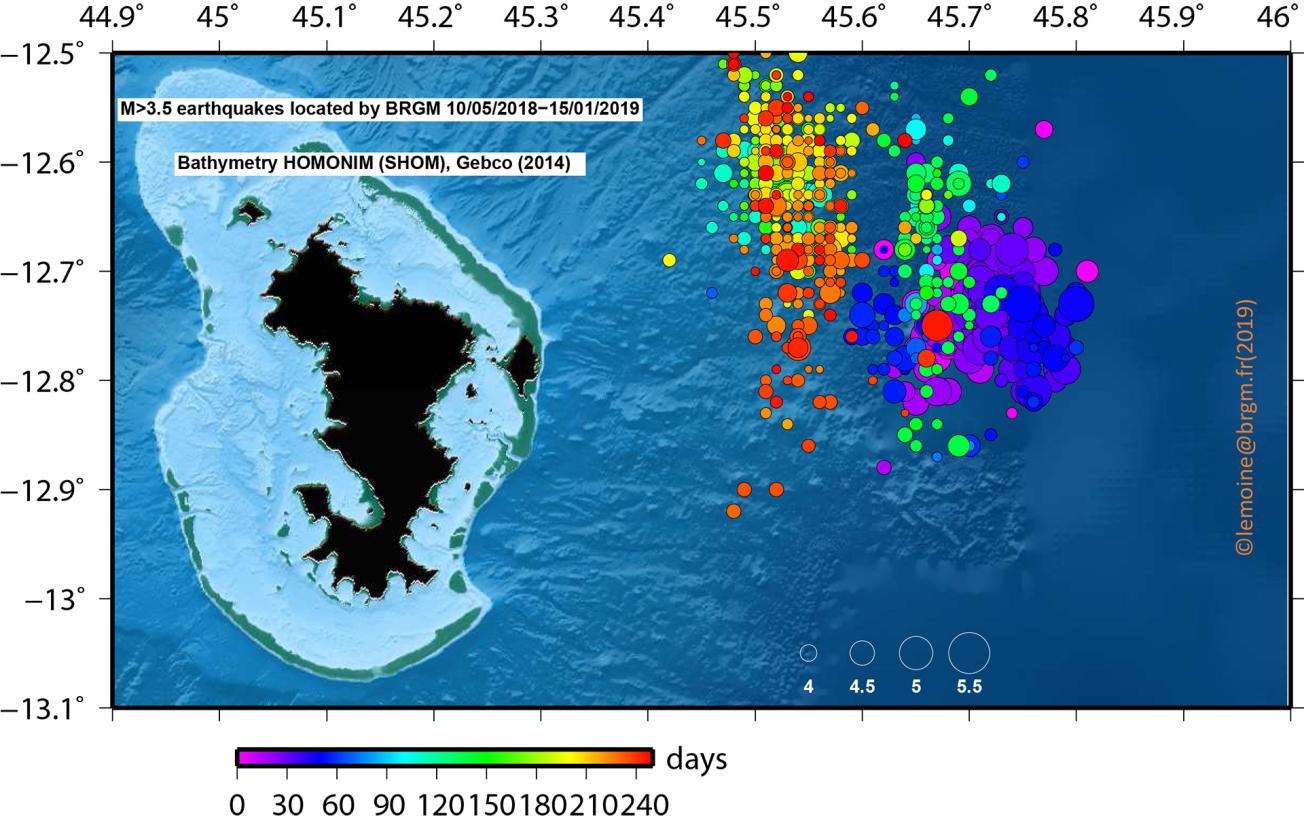
Location of tremors between 10 May 2018 and 15 January 2019 during the seismo-volcanic earthquake swarm in Mayotte.
© BRGM - Anne Lemoine
The need
Since 10 May 2018, Mayotte has been experiencing a seismic crisis in the form of an earthquake swarm, probably related to a large-scale undersea volcanic eruption. The highest magnitude so far, at 5.9, occurred on 15 May 2018 and is the strongest earthquake on record for the Mayotte region. By the end of February 2019, 1608 tremors of magnitude 3.5 and more had been recorded, 472 of magnitude 4.0 and more, and 29 of a magnitude higher than 5.0. The earthquakes have caused moderate damage and some slight injuries. They are causing considerable concern locally and underline Mayotte's vulnerability to earthquakes.
The results
The BRGM is the only public geo-scientific organisation working in Mayotte and has been helping the authorities since the start of the crisis by supplying reliable information to support crisis management, inform the media and reassure the population. It has done so in particular through:
- daily monitoring of seismicity thanks to the signals transmitted by the BRGM's seismic stations in Mayotte and by international seismological networks in the vicinity;
- regular transmission of more than one hundred seismological bulletins to the Prefect of Mayotte and the various Ministries concerned;
- participation of a BRGM expert in an interministerial assessment mission;
- responses to information requests from the press and dedicated pages, with FAQs, set up on the BRGM website for the public and the media.
The scale of this ongoing seismo-volcanic event has spurred international interest, led by the BRGM, in understanding the phenomena under way and how they are evolving. Several major scientific projects have been launched, such as the SISMAORE deep-sea oceanographic campaign, the ANR "COYOTES" project and the CNRS/INSU TelluS-Mayotte project piloted by CNRS-INSU, which deployed inland and offshore seismometers in February and March 2019 to reinforce the observation network in which the BRGM is also involved. The BRGM has deployed an additional accelerometric station on the island of Mayotte and modernised its existing network.

Lake Dziani, a vestige of recent volcanic activity in Mayotte (2019).
© BRGM - Frédéric Tronel
Using the results
Seismicity monitoring by the stations on Mayotte has produced better interpretations of seismic signals and more accurate earthquake location and magnitude estimations than those provided by the international networks, and has also lowered the magnitude detection threshold compared to those networks. The resulting more exhaustive data are contributing to a better understanding of the phenomena and of the way the crisis is evolving, thus underlining the importance of high-quality seismological data.

We had been working with the BRGM for many years, essentially on topics like water shortages and landslips, but since May 2018, the seismic crisis has prompted us to call on its scientists to provide explanations for the people who live here and who are very worried but also ill-informed. The BRGM is now identified here as an expert organisation in seismic and volcanic phenomena. We hope that it will consolidate its teams and technical equipment on the spot to strengthen its investigations of the phenomenon.







